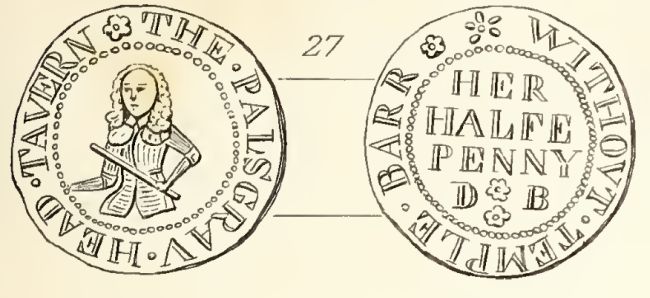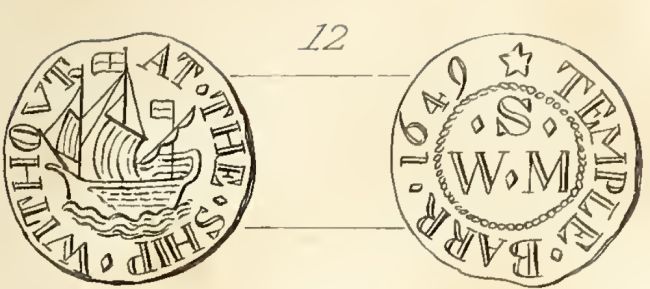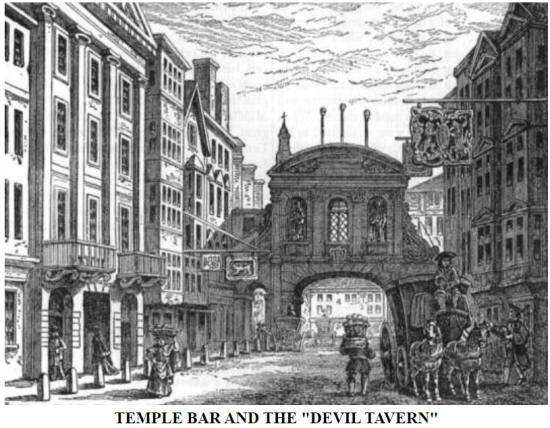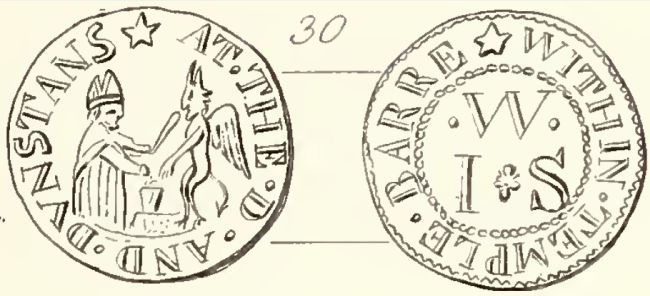Early Inns and Taverns through tradesmens tokens - Temple Bar, within and without
This is a historical site about early London coffee Houses and Taverns and will also link to my current pub history site and also The London street directory
LONDON TRADERS, TAVERN, AND COFFEE-HOUSE TOKENS, CURRENT 1649-1672. :
Index of Tradesmens tokens.
TEMPLE BAR, WITHIN and WITHOUT.
Temple Bar Within, (FLEET STREET.) & Temple Bar Without, ( STRAND). was listed in the Beaufoy collection, now all listed here.
#1083 J0HN BATTELL AT LION Lion rampant, on shield.
Rev. TAVERN AT TEMPLE BAR I. D. B., in the field.
#1084 RICHARD PARROT. WITH Lion rampant, in the field.
Rev. OUT TEMPLE BARRE In the field, R. I. P.
Query, the Red Lion ?
#1085 AT THE WHIT HORSE Horse caprioling: sun in rays
above. Rev. WITHOUT TEMPLE BARR In the field, I. K. I.
The sign was possibly the Sun and White Horse, the device being the same on the
following token.
#1086 JOHN JAMES WITH The sun, above a horse, in the field.
Rev. OVT TEMPLE BARR In the field, I. K. I.
#1087 JOHN LAWTON w ou? St. John's head in a charger.
Rev. TEMPLE BARR In the field, I. I. L.
The sign of the Baptist's Head appears to have been one of much prevalency in
the time of papal domination. The subject seems to have been very generally
adopted by Guido and other eminent painters. In the Ellesmere gallery is a fine
picture by Domenico Feti, of St. John's head in a charger, precisely as depicted
on the tavern signs of old.
#1088 AT THE GOULDEN LOCK A lock, in the field.
Rev. WITHOVT TEMPLE BARR In the field, I. E. M.
#1089 ROBART MATHEWS A plough, in field.
Rev. WITH OUT. TEMPLE BAR In the field, R. M. M.
#1091 JOHN RADFORD AT YE GOULDEN Pair of spectacles, in
the field. Rev. WITHOVT TEMPLE BARR . 68 HIS HALFE PENY. I. E. R.
#1092 AT THE WINDMILL A windmill, in the field.
Rev. WITHOUT TEMPLE BARR In the field, I. P.
The folly of disfiguring sign-boards in mere wantonness is not altogether of
modern date. Sir John Denham the poet, when a student at Lincoln's Inn, in 1635,
though generally temperate as a drinker, having stayed late at a tavern with
some fellow students, induced them to join him in " a frolic," to obtain a pot
of ink and a plasterer's brush, and blot out all the signs between Temple bar
and Charing cross. Aubrey relates that R. Estcourt, esq., carried the ink-pot ;
and that next day it caused great confusion ; but it happened Sir John and his
comrades were discovered, and it cost them some monies.
B3030 Obverse. Edward . Apthorp = Three sugar-loaves.
R. WITH . OUT . TEMPLE . BAR = E . A. 1/4
B3067 Obverse. John . Spicer . at . ye . suger = Three sugar-loaves.
R. WITHOUT . TEMPLE . BARR . l666 = HIS HALFE PENNY.
B3068 Obverse. Joseph. Spicer . at . ye . 3 . svger = Three sugar-loaves.
R. WITHOUT . TEMPLE . BARR . 1666 = HIS HALFE PENNY.
The west side, or " without Temple bar," appears at this period to have been a sort of neutral ground, having no distinctive name, but is now numbered as part of the main street, the Strand.
B3031 Obverse. AT . S . DUNSTANS . TAVERN = I . A . B.
R. AT . TEMPLE . BARR = I . A . B. 1/4
B3032 Obverse. John . Battell . at . lion = A lion rampant.
R. TAVERN . AT . TEMPLE . BAR = I . D . B.
B3033 Obverse. THE . HAND . and . hoaly . bush = A hand holding a holly-bush.
R. at . S. C. [St. Clements] . nere . temple . bab = T . S . B. 1/4
“Evidently the same inn mentioned in 1708 by Hatton, ‘on the north side, and
about the middle of the backside of St. Clements, near the church.’ ”—Larwood
and Hotten’s “ History of Signboards,” p. 250.
B3034 Obverse. GEORGE . BRYAN . AT . YE = A Sugar-loaf.
R. WITHOUT . TEMPLE . BARR = HIS HALFE PENY.
B3035. A variety reads :
Obverse. George . Bryar . at . ye = A sugar-loaf between G . B.
R. Same as that of preceding. 1/2
B3036 Obverse. John . Butler . fruiterer = A lion couchant.
R. WITHOUT . TEMPLE . BARR = HIS HALF PENY.

The Cock Ale House, at Temple Bar 1655 - H M C
B3037 Obverse. THE . COCK . ALE . HOUSE = A COCK.
R. AT . TEMPLE . BARR . 1655 = H . M . C. 1/4
Of this token, one of the rarest in the series, three specimens are known—one
that was formerly handed round at the tavern itself, another belonging to Mr.
Clements, and a third in the possession of my father, Mr. J. Eliot Hodgkin.
There is a cut of it in Akerman’s “ London Tradesmen’s Tokens,” and another,
together with a counterfeit presentment of the bird itself,* in the Illustrated
London News for December 13, 1856.
The house, which was originally called the “ Cock and Bottle,” seems to have
been built in the reign of James I. At all events, it remained internally
unaltered
from the days of the British Solomon until 1882, when it was pulled down to make
room for improvements to Fleet Street.
It was a flourishing tavern in 1665, when the following advertisement appeared
in the Intelligencer: “ This is to notify that the master of the Cock and
Bottle,
commonly called the Cock Ale-house, at Temple Bar, hath dismissed his servants
and shut up his house for this long vacation, intending (God willing), to return
at
Michaelmas next; so that all persons whosoever who have any accompts with the
said master, or farthings belonging to the said house , are desired to repair
thither
before the eighth of this instant July, and they shall receive satisfaction.”
Pepys records several visits to the “Cock,” among them one on April 23, 1668 :
“Thence by water to the Temple, and then to the Cock Alehouse, and drank,
and eat a lobster, and sang, and mightily merry. So almost night, I carried Mrs.
Peirce home, and then Knipp and I to the Temple again, and took boat it being
now night.”
Strype, Book IV., p. 117, says: “The Cock Alehouse, adjoining to Temple
Bar, is a noted publick-house.”
From that time onwards the tavern was frequented by several men of note, more
especially by limbs of the law. Up to the year of its destruction more than one
learned judge might be seen at luncheon-time enjoying his chop and his perfect
pint of stout, concerning which delights see the Laureate’s “ Will Waterproof.”
In 1882 the house was sold to the Commissioners of Sewers for nearly £20,000.
It was pulled down, and the business was transferred to the other side of the
street.
B3038 Obverse. AT . THE . GREEN . CUSHEN = A Cushion.
R. WITHOUT . TEMPLE . BAR = R . M . C. 1/4
B3039 Obverse. Nicholas . cotton = A dragon.
R. WITHOUT . TEMPLE . BAR = N . C. 1/4
B3040 Obverse. THOMAS . DENMAN . AT . THE . KIN = A plough ; beneath, J.
R. GS . HEAD . WITHOUT . TEMPEL . BAR = Bust Of a king holding a sceptre.
1/2
B3041 Obverse. I AM . GOVER . APOTHECAR = A gate.
R. AT . TEMPLE . BARR . 1657 = I . K . G. 1/4
* This sign is said to have been carved by Grinling Gibbons.
B3042 Obverse. Joseph . Gurnei . at . the = A chandler standing within a
crescent.
R. WITHOUT . TEMPLE . BARR = I . I . G. 1/4
B3043 Obverse. O. at . the . Lambe . Taverne = A lamb couchant.
R. temple . bar . WITHOUT = I . H conjoined. 1/4
B3044 Obverse. O. the . Rose . tavern = A full-blown rose.
R. WITHOUT . TEMPLE . BARR = R . E . H. 1/4
B3045 Obverse. O. at . the . man . in . the . moon = A naked man standing within
a crescent. \
R. WITHOUT . TEMPLE . BAR = T . H. 1/4
B3046 Obverse. O. HVGH . HALL . AT . Ye . WHITHART = A hart lodged. H . E . H.
R. WITHOUT . TEMPLE . BAR . 1666 = HIS HALF PENY.
B3047 Obverse. Joseph . Hast . oylman = A dragon.
R. WITHOUT . TEMPLE BARR = I . M . H. 1/4
B3048 Obverse. Thomas . Haward . 1666 = A heart crowned.
R. WITHOUT . TEMPLE . BARR = HIS HALF PENY.
B3049 Obverse. AT . THE . GOLDEN . FLEECE = A fleece.
R. WITHOUT . TEMPLE . BARR = S . A . I. 1/4
A variety reads :
B3050 Obverse. AT . YE . GOLDEN . FLEECE = S . A . I.
R. WITHOUT . TEMPLE . BARR = A fleece. 1/4
B3051 Obverse. John . James . with = A horse and sun.
R. OUT . TEMPLE . BARR = I . K . I.
B3052 Obverse. at . the . crowne = A crown.
R. WITHOUT . TEMPLE . BARR — I . M . K. 1/4
B3053 Obverse. at . the . whit . horse = A horse galloping ; above, the sun.
R. WITHOUT , TEMPLE . BARR = I . K . L. 1/4
B3054 Obverse. O. Tho . Laurence . in . red = A gate, and a pair of antlers.
R. WITHIN . TEMPLE . BARR . 66 = HIS HALF PENY. T . A . L.
B3055 Obverse. John . Lawton . WTH . OUT = The Baptist’s head on a charger.
R. TEMPLE . BARR = I . I . L. 1/4
B3056 Obverse. William . Lovinge . at . the = The Baptist’s head in a dish.
R. WITHOUT . TEMPLE . BARR = HIS HALFE PENNY. W . D . L.
B3057 Obverse. AT . THE . GOVLDEN . LOCK = A door-lock.
R. WITHOUT . TEMPEL . BARR = I . E . M. 1/4
B3058 Obverse. ROBART . MATHEWS = A plough.
R. WITHOUT . TEMPLE . BAR = R . M . M. 1/4
B3059 Obverse. at . the . winde . mill = A windmill.
R. WITHOUT . TEMPLE . BARR = I . P. 1/4
B3060 Obverse. Richard . Parrot . with = A lion rampant.
R. OUT . TEMPLE . BARRE = R . I . P. 1/4
B3061 Obverse. the . elevant . WITHOUT = An elephant with a castle on its back.
R. TAMPEL . BARR . 1650 = G . B . R. 1/4
“ The Poor mans Physician .... Sold by F. Smith at the Elephant and Castle
without Temple Barrel '—The Intelligencer , No. 23, March 27, 1665, p. 197.
B3062 Obverse. the . Pallsgrave . head = Bust of the Palgrave.
R. WITHOUT . TEMPLE . BARR = I . D . R. 1/4
Palsgrave Place, near Temple Bar, on the south side, is the site of the tavern,
formerly of much notoriety.
The Palsgrave Frederick, afterwards King of Bohemia, was affianced to the
Princess Elizabeth in the old banqueting-house at Whitehall, December 27, 1612,
when the sign was doubtless set up in compliment to him.—[B.]
Near the Palsgrave's Head tavern was Heycock's ordinary, much frequented by
parliament men and gallants. Here Andrew Marvell uttered the severe castigation
to certain members of the house, known to be in the pay of the crown., for the
ensuring the subserviency of their votes. Marvell dined usually at this
ordinary in the Strand, where, having eat heartily of boiled beef, with some
roasted pigeons and asparagus, he drank his pint of port ; and on the coming in
of the reckoning, taking a piece of money out of his pocket, held it between his
finger and thumb, and addressing his venal associates, said, " Gentlemen, who
would lett himself out for hire, while he can have such a dinner for
half-a-crown."
B3065 Obverse. the . Palsgrav . Head . tavern = Bust of the Palsgrave Frederick.
R . WITHOUT . TEMPLE . BARR = HER HALFE PENNY. D . B.

The Palsgrav Head Tavern Without Temple Bar. Her Half Penny. Initials D B . And Bust of the Palsgrave Frederick.
B3063 Obverse. the . tallow . chandler = A man dipping candles.
R. WITHIN . TEMPLE . BARR = R . S . R. 1/4
B3064 Obverse. John . Radford . at . YE . goulden = A pair of spectacles.
R. WITHOUT . TEMPLE . BARR . 68 = HIS HALFE PENY. I . L . R.
B3066 Obverse. at . the . ship . WITHOUT = A ship in full sail.
R. TEMPLE . BARR . l649 = W . M . S. 1/4

At the Ship Without Temple Bar 1649 and Initials W M S And a Ship in full sail
The Ship Inn, near Temple Bar, the site now denoted by Ship Yard, is mentioned, among other grants to Sir Christopher Hatton, in 1571.The token, bearing date 1649, is evidence that the inner tavern of that sign was then extant. Walpole, in his memoir of Faithorne, based on Vertue’s notes (“ Catalogue of Engravers,” Dalaway’s edition, 1828, 8vo., p. 132), states, apparently in error, that about 1650 Faithorne returned to England, married, and set up in a new shop at the sign of the Ship, next the Drake, opposite to the Palsgrave Head Tavern, without Temple Bar. The contrary appears; as after the affair at Basing House, in October, 1645, where Sir Robert Peake, the print-seller Faithorne, and other artists and players, as Royalist soldiers, were taken prisoners by the Parliamentarian forces, Faithorne, by leave or otherwise, went to Paris; and there, in his need, sold to the Abbe de Marolles the stock he then possessed of proofs, many now unique, of his own engravings, the whole of which enrich the royal collection at Paris. The year of his return, as stated by Walpole,
is too early. That he was in London in 1653, but not before, seems corroborated by the fact that the portrait of Norah Bridges, prefixed to his “ Vulgar Arithmetic ” published in that year, is certainly by Faithorne, but is wholly without his W. F., or other marks. The portrait of the physician, Dr. Robert Bayfield, with his name, is dated 1654, when possibly as a Royalist he bad ceased to be inimical to the Commonwealth authorities. That Faithorne adopted the sign of the Ship is nowhere indicated.
On the title of his “ Art of ’Graving and Etching ” is stated : “ Published by William Faithorne, and sold at his shop next to ye signe of the Drake, without Temple barr, 1662,” sm. 8vo.
John Reynolds, a cook, issued a token, the device the fox stealing a goose in Ship Yard, in 1666. “The Ship tavern, in the Butcher row near Temple bar,” is noticed in an advertisement so late as June, 1756.—[B.]
The Ship was used as headquarters by Freemasons in Queen Anne’s reign.—
B3069 Obverse. FRANCIS . STONE = MEAL MAN.
R. WITHOUT . temple . barr = A wheatsheaf. 1/4
B3070 Obverse. RICHARD . TAYLER = HIS HALF PENY.
R. AT . TEMPLE . BARR = R . A . T.

Temple Bar and the Devil Tavern
B3071 Obverse. at . the . d . and . Dunstans = St. Dunstan pulling the devil’s
nose with a pair of tongs.
R. WITHIN TEMPLE . BARRE = I . S . W. 1/4

At the D and Dunstans Within Temple Bar. Initials I S W. And St. Dunstan pulling the devil’s nose with a pair of tongs.
St. Dunstan’s, or the Devil Tavern, is mentioned as a house of old repute. In the interlude, entitled, “Jacke Jugeler,” 1563, 4to., Jack, having persuaded his cousin Jenkin,
“As foolish a knave withall
As any is now, within London wall,”
that he was not himself, thrusts him from his master’s door; and, in answer to Jenkin’s sorrowful question—Where his master and he were to dwell?—replies :
“At the Devyll yf you lust, I can not tell.”
The Devil Tavern was a place of great resort in James I.’s reign, and was then in the occupation of Simon Wadlow, whose name appears for the first time, under the erroneous appellation of Simon Waddell, in the list of licensed vintners returned by the wardmote of Farringdon Without, in January, 1609 ; but correctly certified in the return on the following St. Thomas’s Day, December 21, in that year.
At what period Ben Jonson began to frequent this tavern has not been defined. He considered his “Volpone,” the “ Alchymist,” and “ Silent Woman,” among his happiest efforts ; their excellence, as he has remarked, “ owing to the influence of good sack, while the ‘ Devill is an Asse ’ was written when I and my boys drank bad wine at the Devil.” “ My boys ” has reference to his poetically adopted sons. The “Devill is an Asse” was played in 1616.
Simon Wadlow’s name appears for the last time, as a licensed vintner, in the wardmote return of December, 1626 ; and the burial register of St. Dunstan’s notices : “March 30th 1627, Symon Wadlowe, vintner, was buried out of Fleet Street.” On St. Thomas’s Day in the last-named year, the name of “ the widow Wadlowe” appears ; and in the following year, 1628, of the eight licensed vintners, five were widows. The widow Wadlow’s name is returned for the last time by the wardmote on December 21, 1629.
The name of John Wadlow, apparently the son of old Simon, appears firstly as a licensed vintner in the wardmote return on St. Thomas’s Day, December 21, 1646.
He issued the token, showing on its obverse St. Dunstan holding the devil by the nose, his lower half being that of a satyr. The devil on the signboard was, as usual, sable , the origin of the practice being thus satisfactorily explained by Dr. Jortin : “The devils used often to appear to the monks in the figure of Ethiopian boys or men ; thence probably the painters learned to make the Devil black.”
The popularity of the devil, however, has long superseded that of the saint ; and Flecknoe, in his “ ^Enigmatical Characters,” 1658, 8vo., either in allusion to the sign, or the token, while observing on the Puritanical changes effected among the tavern signs by the then fanatical reformers, says “ there only wants their making the dragon to kill St. George, and the Devil to tweak St. Dunstan by the nose, to make the reformation compleat.”
Wadlow, after the Great Fire in September, 1666, rebuilt the Sun Tavern behind the Royal Exchange ; and he appears to have been sufficiently wealthy to have advanced money to the Crown. His autograph was attached to several receipts among the myriads of Exchequer documents recently destroyed.
Dean Swift, in his “Journal to Stella,” October 12, 1710, writes: “I dined to-day with Dr Garth and Mr Addison, at the Devil Tavern by Temple Bar ; and Garth treated.”
In January, 1720, one of the many fraudulent suggestions to rob the unwary, caused by the South Sea scheme, was a projected “ Insurance Office for .Servants Thefts,” at the Devil Tavern, in 3,000 shares of ^1,000 each.
In October, 1734,-Taylor, of St. Bride’s parish, was certified as the owner of the two houses adjoining the Middle Temple Gate, the old Devil Tavern being then in the occupation of John Goostrey. In 1746 the Royal Society held here their annual dinner ; and in 1752 concerts of vocal and instrumental music were given in the great room.
A view of the exterior of the Devil Tavern, with its gable-pointed front, engraved from a drawing by Wale, was published in Dodsley’s “London and its Environs,” 1761. The sign-iron bearing its pendant sign represents the latest effort of the artist, the saint being painted as a half-length, and the devil behind him grinning grimly over his shoulder. On the removal of signs by authority, it was, in 1764, placed flat against the front, and there remained till the demolition of the house.
In July, 1766, Richard Andrews, of St. Dunstan’s parish, became the purchaser of Taylor’s property in the two houses ; and on the morning of Saturday, October 12, 1771, the Devil Tavern was accidentally set on fire. The mischief was, however, by the promptness of the engines, early subdued without much damage.
Dr. Hewick, in January, 1774, attempted a series of lectures in the Apollo at the Devil Tavern, which he termed the School of Shakespeare. His manner of delivery, and reckless abuse of existing commentators, gained him no popularity, and after a few evenings failed to attract. A print, showing the interior of the Apollo, the doctor on a dais lecturing, and audients in the balustraded music-gallery, was published at the time in a magazine, but is now excessively rare.
Brush Collins, in March, 1775, delivered for several evenings in the great room a satirical, mimical, and analytical lecture on the elements of modern oratory. In the following year, a Pandemonium club was held here ; and, according to a notice in the writer’s possession, the first meeting was to be on Monday, November 4, 1776. These devils were lawyers, who were about commencing term, to the annoyance of many a hitherto happy bon-viuant .
From bad to worse the Devil Tavern fell into disuse, and Messrs. Child purchased the freehold of Andrews, in June, 1757, for £2,800. It was soon after demolished, and the site is now occupied by the houses called Child’s Place.—[B.]
“ Wadlow the Vintner, at the Devil in Fleet Street, did lead a fine company of soldiers, all young comely men in white doublets.”—Pepys’ “ Diary,” April 22, 1661.
The Devil was used by Freemasons as their headquarters in the reign of Queen Anne. For others, see Appendix.
B3072 Obverse. Obverse. O . at . the . dolphin = A dolphin.
R. WITHIN . TEMPLE . BARR = W . M . W. 1/4
The Dolphin at an earlier date would seem to have been a house of no great reputation. At the wardmote courts of 1640 and 1641, Timothy Howe, at the Dolphin near Temple Bar, was presented for using unlawful measures. Howe appears to have been several times under the ban of the inquest. He and others then residing in Ram Alley were, in December, 1618, presented for keeping their tobacco-shops open all night, and having fires therein, to which there were no chimneys ; for uttering hot waters (spirituous liquors), and selling ale without licence ; to the great disquietness, terror, and annoyance of that neighbourhood. Howe was again, with others, presented in December, 1630, for annoying the judges at Serjeants’ Inn, Chancery Lane, by the smell and stench of their tobacco.—[B.]
B3073 Obverse. THOMAS . WASTCOATE . IN . STAR = HIS HALFE PENY.
R. covrt . WITHOUT . temple . bar = A blazing star.
###
As ever I am appreciative of the archive.org site and google books for
showing old and non-copyright scripts which can be used for research (copied).